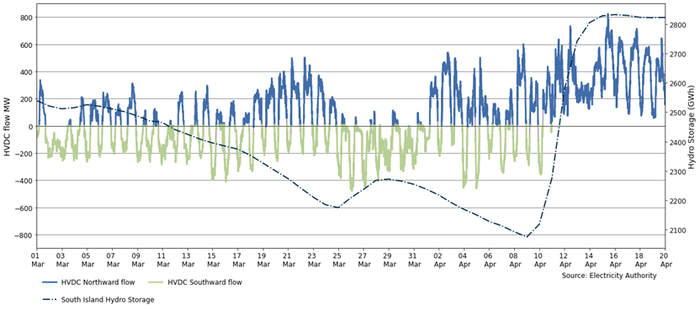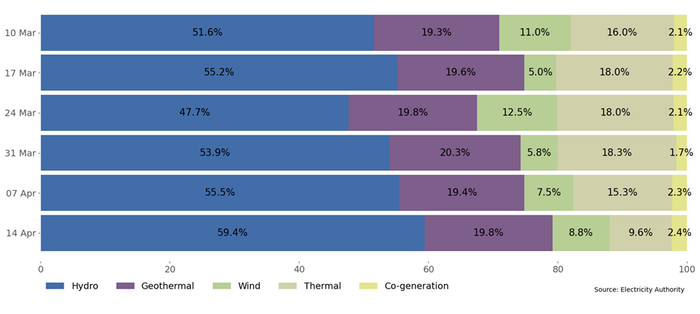Eye on electricity
How the HVDC balances electricity supply and demand
- Generation
- Wholesale
Electricity supply and demand differ across New Zealand’s two main islands. The South Island has abundant hydro generation, while the North Island is more populated and typically consumes more electricity.
High-voltage direct current cables (HVDC) allow electricity produced in either island to flow to the other. The cables normally transfer electricity northward during the day and southwards overnight.
In March 2024, however, high levels of electricity were transferred south, even during daytime periods, as hydro storage in the southern lakes fell. In mid-April hydro storage increased, and the HVDC transferred electricity north for several days. This article explains how the electricity market reacts to changing supply and demand conditions using the HVDC.
Electricity spot prices vary to reflect underlying conditions, including hydro reservoir levels
Most of New Zealand’s electricity comes from renewable sources, like wind, geothermal and increasingly solar. However, the electricity system is dominated by hydroelectric dams.
Many hydro schemes have storage reservoirs and the stored water has an intrinsic value. When hydro storage is low, electricity generation from hydro is sold at higher prices into the wholesale market, as this reflects the increasing scarcity of water.
Weather impacts electricity supply in both islands
In 2024, between 1 February and 9 April, hydro storage steadily declined across New Zealand. As this occurred, the value of stored water in reservoirs increased, and less electricity was generated by hydropower. During this time several large thermal generators ran to produce sufficient electricity to match demand.
Throughout February and March, when North Island wind generation was high, the HVDC transferred electricity southwards. This allowed South Island hydro generation to ramp down and more water was stored in the southern reservoirs for winter (when electricity demand will be highest). Figure 1 shows how more electricity flowed southward in March 2024 and South Island hydro storage declined.
The relationship between wind and hydro generation in March and April 2024 is shown in Figure 2. Since thermal generation was relatively constant in March, the electricity market, facilitated by the HVDC, allowed hydro generation to ramp down during weeks with high wind, as seen in the weeks starting 10 and 24 March.
In mid-April 2024, heavy rainfall hit the South Island and hydro storage increased by over 700GWh. The electricity market responded by transferring more electricity to the North Island (see Figure 1 from 10 April 2024). This allowed some North Island thermal generators to switch off and save fuel for winter. (See Figure 2 for the reduction in thermal generation from 14 April 2024.)
The HVDC and spot price signals help match electricity supply with demand
When hydro storage is declining less hydro generation is used for electricity production and spot prices generally increase. The HVDC facilitates even greater reductions in hydro generation when wind generation is high. This saves water for winter when electricity demand is at its highest.
When hydro storage increases, the market responds by transferring more electricity northward. This allows thermal power stations to run less and save fuel for winter which helps maintain security of supply.


Related News
Contract extension for commercial market making services
The Electricity Authority Te Mana Hiko has extended by eight months the end of the current contract to provide commercial market making services.
Centralised wind and solar forecaster contract awarded
The Electricity Authority has awarded a contract to provide centralised wind and solar forecasting services to DNV Services.
Battery energy storage systems roadmap released
We have published a draft two-year roadmap that sets out our work to support investment in battery energy storage systems (BESS). BESS will become increasingly…